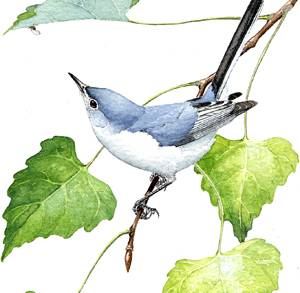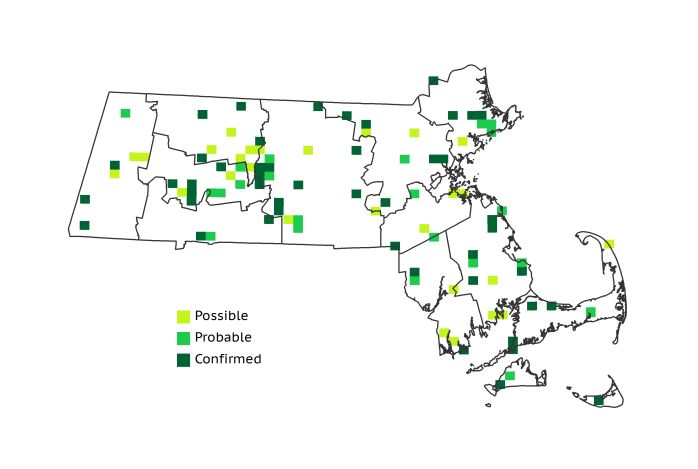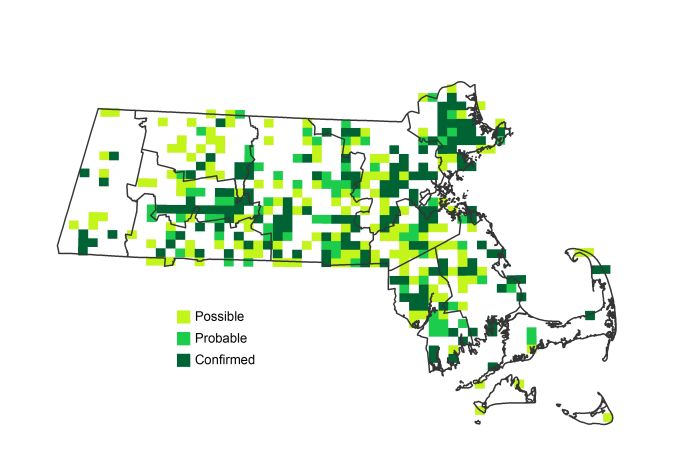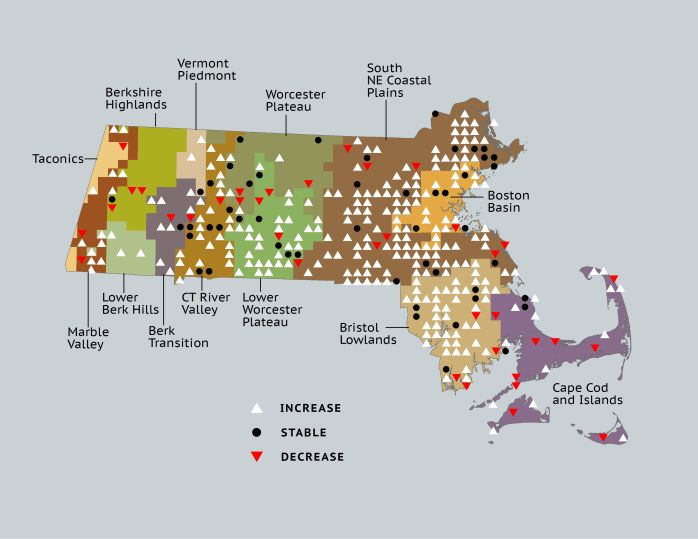Find a Bird
Blue-gray Gnatcatcher
Polioptila caerulea

Fairly widespread and strongly increasing
“At times, when the birds were very busy, I could hear a soft ‘tsee, tsee, tsee,’ no louder than the squeak of a mouse.” – Millie Noel Long, Birds and Nature in Natural Colors
The Blue-gray Gnatcatcher is a fairly recent arrival from the southern US, where the species has long been known for its incessant, buzzy calls as it scours the canopy for invertebrates to eat. These high-energy insectivores seem to be always on the move, hopping from twig to twig, using their long tails for balance. Like many other southern species moving north, Blue-gray Gnatcatchers have shown every indication of becoming a permanent addition to the breeding avifauna of Massachusetts.
Historic Status
As of 1902, Massachusetts bird lovers could count on two hands the number of times anyone had positively identified a Blue-gray Gnatcatcher in the state. It wasn’t until November of that year that Francis H. Allen first located one in West Manchester (Allen 1903). Forbush noted that the “fidgety little midget” was recorded more regularly from April to December over the course of the next two decades (Forbush 1929). By 1960, the species was still regularly seen as a transient, and shortly thereafter gnatcatchers began breeding in Massachusetts (Veit & Petersen 1993). This expansion was likely aided in part by the increase in preferred wetland habitat caused by the return of Beavers to Massachusetts, which were then expanding eastward across the state.
Atlas 1 Distribution
During Atlas 1 Blue-gray Gnatcatchers were breeding, albeit in small numbers, in all corners of the state. Most of the far western ecoregions had reports of gnatcatchers, save the Lower Berkshire Hills, and the well-watered Connecticut River Valley had 9 blocks with breeding evidence. If the scattered reports of the uncommonly encountered Blue-gray Gnatcatcher had a particular center in Massachusetts, it was in the Quabbin area, at the intersection of the Lower Worcester and Worcester Plateau regions. The Coastal Plains had 23 blocks occupied by gnatcatchers, but these accounted for less than 10% of the blocks in that large region, though they constituted 24% of the species’ statewide range. Gnatcatchers were likewise present but widely scattered in the Boston Basin, Bristol/Narragansett Lowlands, and Cape Cod.
Atlas 2 Distribution and Change
Joining the ranks of other rapidly expanding southern species like Carolina Wren, Northern Cardinal, and Northern Mockingbird, Blue-gray Gnatcatchers were continuing their broad-front colonization of all regions in Massachusetts by the time of Atlas 2. The species went from an overall block occupancy rate of about 10% in Atlas 1 to nearly 38% in Atlas 2. The highest elevations in the state reported some of the lowest block occupancy for gnatcatchers, with the Taconics, Berkshire Highlands, and Lower Berkshire Hills all hosting less than 20% block occupancy. The state was “book-ended” with low block occupancy in the Cape and Islands region, but otherwise all the remaining ecoregions in the state showed a 25% or higher gnatcatcher presence. Particular growth was noted in the Connecticut River Valley, Coastal Plains, Boston Basin, and Bristol/Narragansett Lowlands, all contributing to an effort-controlled gain of 27% of the state.
Atlas 1 Map

Atlas 2 Map

Atlas Change Map

Ecoregion Data
Atlas 1 | Atlas 2 | Change | ||||||
Ecoregion | # Blocks | % Blocks | % of Range | # Blocks | % Blocks | % of Range | Change in # Blocks | Change in % Blocks |
Taconic Mountains | 1 | 6.3 | 1.0 | 1 | 4.0 | 0.3 | 0 | 0.0 |
Marble Valleys/Housatonic Valley | 2 | 5.1 | 2.1 | 8 | 20.5 | 2.0 | 6 | 15.4 |
Berkshire Highlands | 4 | 7.3 | 4.2 | 4 | 7.3 | 1.0 | -1 | -1.9 |
Lower Berkshire Hills | 0 | 0.0 | 0.0 | 5 | 16.1 | 1.3 | 5 | 18.5 |
Vermont Piedmont | 2 | 11.8 | 2.1 | 6 | 35.3 | 1.5 | 2 | 16.7 |
Berkshire Transition | 3 | 7.9 | 3.1 | 16 | 40.0 | 4.1 | 7 | 22.6 |
Connecticut River Valley | 9 | 16.1 | 9.4 | 35 | 53.8 | 9.0 | 20 | 41.7 |
Worcester Plateau | 9 | 11.5 | 9.4 | 25 | 28.4 | 6.4 | 5 | 10.4 |
Lower Worcester Plateau | 14 | 18.9 | 14.6 | 47 | 58.8 | 12.0 | 22 | 40.7 |
S. New England Coastal Plains and Hills | 23 | 8.5 | 24.0 | 146 | 51.6 | 37.3 | 93 | 41.2 |
Boston Basin | 6 | 10.7 | 6.3 | 25 | 44.6 | 6.4 | 19 | 34.5 |
Bristol and Narragansett Lowlands | 11 | 10.4 | 11.5 | 53 | 46.5 | 13.6 | 39 | 38.6 |
Cape Cod and Islands | 12 | 8.8 | 12.5 | 20 | 13.9 | 5.1 | 5 | 4.2 |
Statewide Total | 96 | 9.9 | 100.0 | 391 | 37.7 | 100.0 | 222 | 26.8 |
Notes
The Blue-gray Gnatcatcher shows a significant increasing Breeding Bird Survey trend in the New England/Mid-Atlantic Region and in the Eastern US overall.



